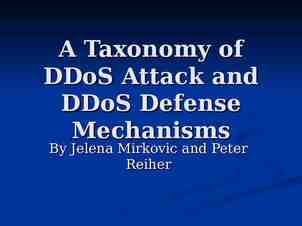New Feature of NCEP ATP III:* Identification of the Metabolic
30 Slides2.44 MB

New Feature of NCEP ATP III:* Identification of the Metabolic Syndrome Positive diagnosis based on the presence of three or more of the following: Risk Factor Defining Level Abdominal obesity (waist circumference† ) Men Women Triglycerides HDL cholesterol Men Women Blood pressure Fasting glucose March 7, 2023 102 cm ( 40 in) 88 cm ( 35 in) 150 mg/dL 40 mg/dL 50 mg/dL 130/ 85 mm Hg 110 mg/dL 1

INSULIN RESISTANCE An impaired biological response to insulin – Resistance to insulin-stimulated glucose uptake An impairment of normal glucose uptake by muscle Unregulated overproduction of glucose by the liver Core defect in T2DM Underlying defect in the metabolic syndrome (clinical picture) March 7, 2023 2

Visceral obesity is associated with a cluster of metabolic abnormalities March 7, 2023 3

Metabolic Syndrome: Total and CV Mortality in Middle-Aged Men in Kuopio Heart Study Cumulative Hazard (%) All-Cause Mortality 20 Metabolic Syndrome 20 Metabolic Syndrome Yes RR (85% CI) 2.13 (1.64-3.61) 15 Cardiovascular Disease Mortality RR (85% CI) 3.55 (1.96-6.43) 15 10 10 Yes No 5 5 No. at 0 Risk Metabolic Syndrome No 0 0 2 6 8 10 12 0 Follow-up (Years) Yes 866 No 288 March 7, 2023 4 852 279 834 234 2 4 6 8 10 12 Follow-up (Years) 292 100 Yes 866 No 288 852 279 834 234 292 100 4

March 7, 2023 5

March 7, 2023 6

March 7, 2023 7

ROLE OF PEROXISOME PROLIFERATORACTIVATED RECEPTORS PPARs—Steroid hormone nuclear receptors Act as ligand-activated transcription factors Control expression of specific target genes Protein products control a variety of cellular functions PPAR-alpha family is a critical regulator of fatty acid metabolism Expressed throughout vasculature; limits adhesion molecule expression,tissue factor production PPAR-gamma family plays central role in fatty tissue production,fat metabolism,glucose regulation Highly expressed in endothelial cells,smooth muscle cells,lymphocytes,macrophages March 7, 2023 8

March 7, 2023 9

PPARa regulates Apo A-I, Apo A-II, LPL, ABCA-1 and SR-BI expression March 7, 2023 10

March 7, 2023 11

Oral Agents for Type 2 Diabetes: Primary Sites of Action Sulfonylureas Repaglinide Acarbose Miglitol Gut Pancreas Impaired Insulin Insulin Deficiency Secretion Carbohydrate Metabolism Hyperglycemia Hepatic Glucose Production Glucose Insulin Uptake Resistance Muscle Liver Metformin March 7, 2023 Rosiglitazone Pioglitazone 12

PPAR-GAMMA ACTIVATORS (“glitazones”) Reduce plaque inflammation Inhibit expression of adhesion molecules and cytokines Reduce production of Matrixmetalloproteinases Reduce thrombogenicity and enhance fibrinolysis Enhance reverse cholesterol transport and reduce cholesterol content of plaque March 7, 2023 13

Established Modifiable CV Risk Factors in T2DM UKPDS 23: CAD Position in Model Variable P Value* First Low-density lipoprotein cholesterol 0.0001 Second High-density lipoprotein cholesterol 0.0001 Third Hemoglobin A1c 0.0022 Fourth Systolic blood pressure 0.0065 Fifth Smoking 0.056 March 7, 2023 14

Effect of Glycemic Control in the UK Prospective Diabetes Study (UKPDS) Endpoints Intensive (rate/1000 pt yrs) Conventional (rate/1000 pt yrs) P % Decrease Any diabetes related* 40.9 46 0.029 11 MI 14.7 17.4 0.052 16 Stroke 5.6 5 0.52 – PVD 1.1 1.6 0.15 – Microvascular 8.6 11.4 0.0099 * Combined microvascular and macrovascular events March 7, 2023 25 15

Effect of Blood Pressure Control in the UKPDS Tight vs. Less Tight Control 1,148 Type 2 patients Average BP lowered to 144/82 mmHg (controls: 154/87); 9-year follow-up Tight Control Risk Reduction (%) P value Any diabetes-related endpoint 24 0.0046 Diabetes-related deaths 32 0.019 Heart failure 56 0.0043 Stroke 44 0.013 Myocardial infarction 21 NS Microvascular disease 37 0.0092 March 7, 2023 16

UKPDS: Comparison Between Tight Control of BP and Glycemia on Risk of Diabetes Complications Any Diabetes- Diabetesrelated Micro- Retino- Stroke related pathy Outcome Death vascular CHF 0 –10 –20 % –30 –40 –50 –60 Tight BP (144/82 vs 154/87 mmHg) Tight glucose (HbA1c 7% vs 7.9%) March 7, 2023 17

Major Outcomes of the Hypertension Optimal Treatment (HOT) Trial: Diabetes Subgroup Events / 1000 Pt-Years 30 25 Diastolic Target p 0.005 90 mmHg (N 501) 85 mmHg (N 501) 20 80 mmHg (N 499) 15 p 0.045 10 p 0.016 5 0 Major CV Events March 7, 2023 MI CV Mortality Hansson L et al. Lancet 1998;351: 1755-1762. 18

Heart Outcomes Prevention Evaluation (HOPE) Study Effect of Ramipril on Cardiovascular Events (Myocardial Infarction, Stroke, or CVD Death) 4.5 Yr % of Patients 25 20 15 24% 19.8 Risk Reduction 15.0 10 21% 16.4 Risk Reduction 13.0 5 0 March 7, 2023 Placebo Ramipril Diabetic Patients N 3,578, P 0.001 Placebo Ramipril Nondiabetic Patients N 5,719, P 0.001 19

MICRO-HOPE: Ramipril Significantly Reduces Cardiovascular Morbidity Risk Reduction (%) Ramipril Effects Beyond Baseline Therapy Diuretics Aspirin Beta-Blockers Other Antiplatelet Agents Calcium-Channel Blockers Lipid-Lowering Agents 0 Stroke Nonfatal MI CV Death -5 -10 -15 -20 -25 22% -30 † -35 -40 33% * 24% § 37% ‡ March 7, 2023 Total Mortality P 0.0074 † P 0.01 ‡ P 0.0001 § P 0.0004 * 20

March 7, 2023 Angina and Coronary Artery Disease in Patients with Diabetes Mellitus 21

Evolving Science: Central Role of Ang II in Atherosclerosis Endothelial Dysfunction Inflammation Impaired NO synthase Thrombosis Lipid Oxidation IL-5 MCP-1 PDGF LOX-1 Angiotensin II VCAM ICAM Adhesion PAI-1 TF Proliferation Fibrosis March 7, 2023 TGF- Angiotensin Autostimulation 22

Antiplatelet Agents Reduce CVD Events in Patients with Diabetes: Antiplatelet Trialists’ Collaboration CVD Events (%) 25 P 0.002 20 Antiplatelet Therapy Control P 0.00001 15 10 5 0 March 7, 2023 Diabetes No Diabetes 23

CHD Incidence by HbA1c Levels in Type 2 Diabetic Subjects Incidence (%) in 3.5 y HbA1c tertile 25 20 15 Low 6% Middle 6% to 7.9% High 7.9% † * 10 5 0 CHD Mortality All CHD Events *P 0.01 vs. lowest tertile; †P 0.05 vs. lowest tertile; n 229 men and women. Patients 65–74 years old with T2DM at baseline. March 7, 2023 24

March 7, 2023 25

March 7, 2023 26

COLLABORATIVE ATORVASTATIN DIABETES STUDY (CARDS) To evaluate the effectiveness and safety of atorvastatin 10mg daily versus placebo in the primary prevention of cardiovascular disease (major coronary events, revascularisation and stroke) in patients with type 2 diabetes without raised cholesterol levels March 7, 2023 27

CARDS:Cumulative Hazard for Primary Endpoint Cumulative Hazard (%) Relative Risk Reduction 37% (95% CI: 17-52) 15 P 0.001 Placebo 127 events 10 Atorvastatin 83 events 5 0 0 Placebo 1410 Atorva 1428 March 7, 2023 1 2 3 4 4.75 1351 1392 1306 1361 1022 1074 651 694 305 328 Years 28

CARDS: Treatment Effect on the Primary Endpoint Event Hazard Ratio Placebo* Atorva* Risk Reduction (CI) 83 (5.8%) 37% (17-52) p 0.001 Acute coronary events 77 (5.5%) 51 (3.6%) 36% (9-55) Coronary revascularisation 34 (2.4%) 24 (1.7%) 31% (-16-59) Stroke 39 (2.8%) 21 (1.5%) 48% (11-69) Primary endpoint 127 (9.0%) .2 .4 .6 .8 * N (% randomised) 1 1.2 Favours Atorvastatin Favours Placebo

PREVENTION OF DIABETIC ATHEROTHROMBOSIS Aggressive treatment of at-risk patients should be pursued, following the latest guideline recommendations Lipid lowering reduces clinical events and appears to stabilize plaque ACE inhibitors reduce clinical events and may have antiatherosclerotic actions Anti-platelet agents prevent thrombotic events Glycemic control is effective in reducing risk of microvascular events and coronary events March 7, 2023 31






